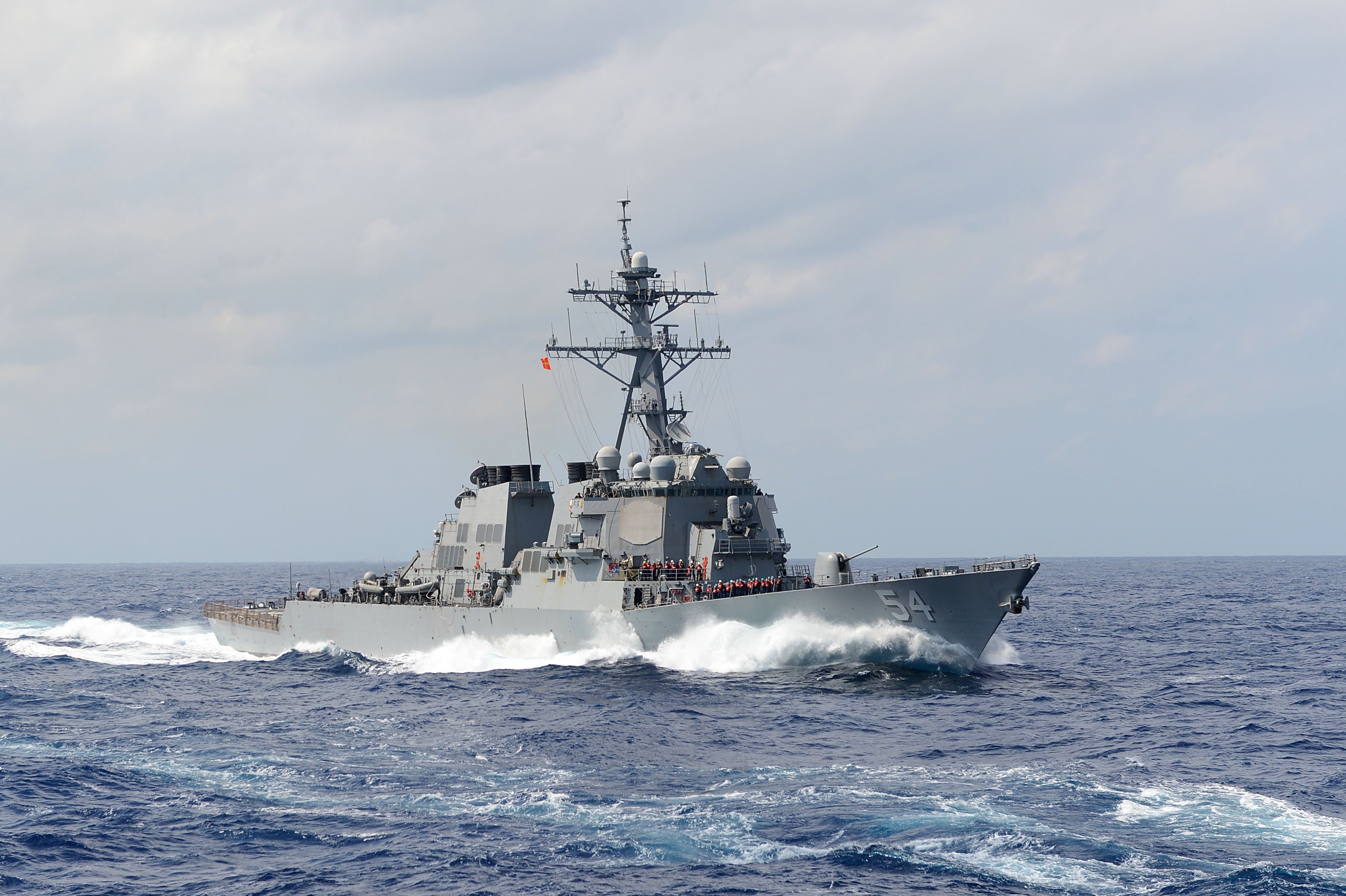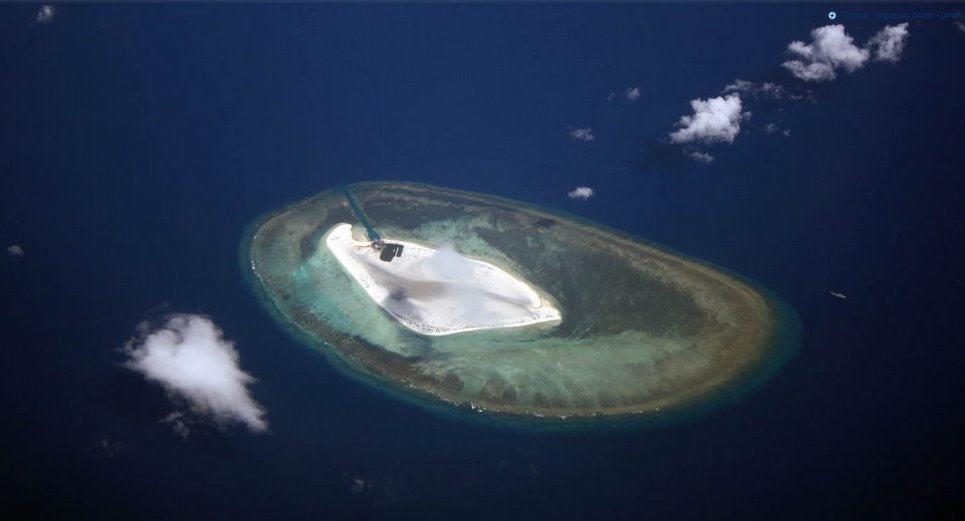
An American guided missile destroyer conducted a freedom of navigation operation within 12 nautical miles of a disputed island claimed by China in the South China Sea Paracel island chain, Pentagon officials confirmed to USNI News on Saturday morning.
USS Curtis Wilbur (DDG-54) came within 12 nautical miles of Triton Island in the Paracels — without prior notification — in an early Saturday morning operation local time (late Friday night EST), according to a statement from the Department of Defense.
“This operation challenged attempts by the three claimants, China, Taiwan and Vietnam, to restrict navigation rights and freedoms around the features they claim by policies that require prior permission or notification of transit within territorial seas,” Pentagon spokesman Mark Wright said in a Saturday morning statement.
“The excessive claims regarding Triton Island are inconsistent with international law as reflected in the [U.N.] Law of the Sea Convention.”
Triton Island is administered by mainland China which seized administrative control of the island from the then-government of South Vietnam in a 1974 following a two-day naval engagement — the Battle of the Paracel Islands. Triton Island is also claimed by Vietnam and Taiwan.
China claims it has a territorial boundary around the Paracel chain — a straight baseline — much like the maritime boundary around the islands that make up Indonesia, James Kraska, professor in the Stockton Center for the Study of International Law at the Naval War College, told USNI News Saturday morning. China also requires prior notification of foreign warships before it comes with in a certain distance of its South China Sea claims — which is not a right enshrined in international maritime law.
Kraska said the decades old Chinese claims around the islands run counter to the definition of straight baselines in the Law of the Sea Convention and international maritime law.
“We’ve challenged [the baselines], but those were overflights,” he said.
“This is the first time in a long long while there has been a surface challenge of the illegal baseline.”
Unlike October’s FON op in the Spratly Islands — in which USS Lassen (DDG-82) conducted an innocent passage transit within 12 nautical miles of a Chinese artificial island on Subi Reef in deference to another feature that overlapped — there was no ambiguity to what excessive claim the U.S. challenged, Kraska said.
“China has established unlawful strait baselines around all the islands — which is illegal,” he said. He added Wilbur’s passage is a “more sound assertion” of international rights of transit than the message sent after the Lassen passage past Subi Reef.
Experts and lawmakers alike were confused when news of the Subi Reef innocent passage FON op broke as to what exactly the U.S. was challenging to the point where Senate Armed Services Committee chair Sen. John McCain (R-Ariz.) asked Secretary of Defense Ash Carter formally for an explanation of the operation’s intent.
According to Kraska, the key now for the U.S. is make the FON ops in the region a more regular occurrence.
“The longer you wait you challenge something, the bigger deal it becomes from a political crisis standpoint because it looks out of the ordinary,” he said.
“Now we have to return to normalcy where all countries are accustomed to the norms that are going to be followed.”

Earlier this week in Washington, U.S. Pacific Command commander Adm. Harry Harris the U.S. would conduct more FON ops in the South China Sea.
“You will see more of these,” he said at an address at the Center for Strategic and International Studies (CSIS).
China did not immediately issue a reaction to the operation but Wilbur’s passage comes days after U.S. Secretary of State John Kerry met with Chinese president Xi Jinping and foreign minister Wang Yi in China.
According to state controlled press reports from a Jan. 27 press conference, Wang said the the U.S. and China should treat the South China Sea claims issue in a, “constructive way and ensure that the big picture of cooperation between China and the US will not be interfered.”
The following is the complete Jan. 30 statement on USS Curtis Wilbur’s freedom of navigation mission past Triton Island from the Office of the Secretary of Defense.
I can confirm the Department of Defense conducted a freedom of navigation operation in the South China Sea on Jan 30 (Jan 29 EST), specifically in the vicinity of Triton Island in the Paracel Islands, to challenge excessive maritime claims of parties that claim the Paracel Islands.
This operation challenged attempts by the three claimants, China, Taiwan and Vietnam, to restrict navigation rights and freedoms around the features they claim by policies that require prior permission or notification of transit within territorial seas. The excessive claims regarding Triton Island are inconsistent with international law as reflected in the Law of the Sea Convention.
During the operation, the USS Curtis Wilbur, (DDG 54) transited in innocent passage within 12 nautical miles of Triton Island.
This operation was about challenging excessive maritime claims that restrict the rights and freedoms of the United States and other, not about territorial claims to land features. The United States takes no position on competing sovereignty claims between the parties to naturally-formed land features in the South China Sea. The United State does take a strong position on protecting the rights, freedoms, and lawful uses of the sea and airspace guaranteed to all countries, and that all maritime claims must comply with international law.
No claimants were notified prior to the transit, which is consistent with our normal process and international law.
This operation demonstrates, as President Obama and Secretary Carter have stated, the United States will fly, sail and operate anywhere international law allows. That is true in the South China Sea, as in other places around the globe.
Since 1979, the U.S. Freedom of Navigation program has demonstrated non-acquiescence to excessive maritime claims by coastal states all around the world. The program includes both consultations and representation by U.S. diplomats and operational activities by U.S. military forces.





